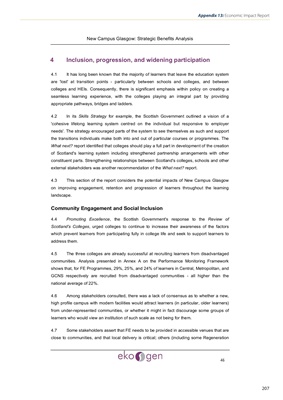
New Campus Glasgow: Strategic Benefits Analysis
46
4 Inclusion, progression, and widening participation
4.1 It has long been known that the majority of learners that leave the education system
are 'lost' at transition points - particularly between schools and colleges, and between
colleges and HEIs. Consequently, there is significant emphasis within policy on creating a
seamless learning experience, with the colleges playing an integral part by providing
appropriate pathways, bridges and ladders.
4.2 In its Skills Strategy for example, the Scottish Government outlined a vision of a
'cohesive lifelong learning system centred on the individual but responsive to employer
needs'. The strategy encouraged parts of the system to see themselves as such and support
the transitions individuals make both into and out of particular courses or programmes. The
What next? report identified that colleges should play a full part in development of the creation
of Scotland's learning system including strengthened partnership arrangements with other
constituent parts. Strengthening relationships between Scotland's colleges, schools and other
external stakeholders was another recommendation of the What next? report.
4.3 This section of the report considers the potential impacts of New Campus Glasgow
on improving engagement, retention and progression of learners throughout the learning
landscape.
Community Engagement and Social Inclusion
4.4 Promoting Excellence, the Scottish Government's response to the Review of
Scotland's Colleges, urged colleges to continue to increase their awareness of the factors
which prevent learners from participating fully in college life and seek to support learners to
address them.
4.5 The three colleges are already successful at recruiting learners from disadvantaged
communities. Analysis presented in Annex A on the Performance Monitoring Framework
shows that, for FE Programmes, 29%, 25%, and 24% of learners in Central, Metropolitan, and
GCNS respectively are recruited from disadvantaged communities - all higher than the
national average of 22%.
4.6 Among stakeholders consulted, there was a lack of consensus as to whether a new,
high profile campus with modern facilities would attract learners (in particular, older learners)
from under-represented communities, or whether it might in fact discourage some groups of
learners who would view an institution of such scale as not being for them.
4.7 Some stakeholders assert that FE needs to be provided in accessible venues that are
close to communities, and that local delivery is critical; others (including some Regeneration
207
Appendix 13: Economic Impact Report